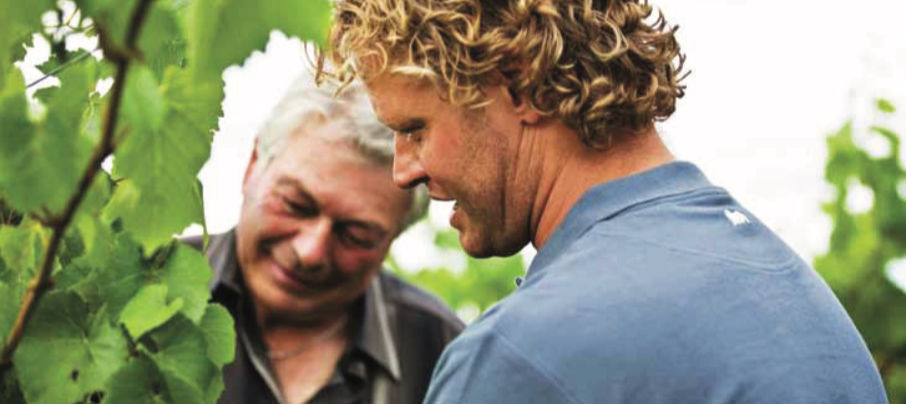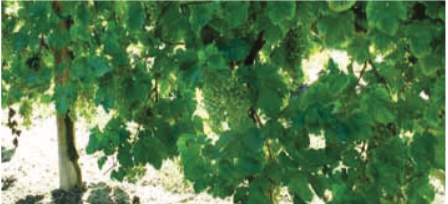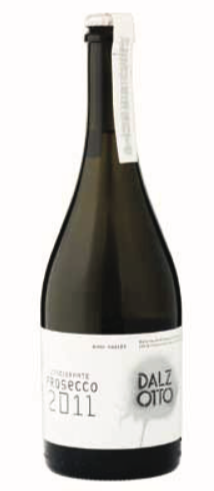By Michael Dal Zotto, Dal Zotto Wines, King Valley, Victoria
First published in the January/February 2015 issue of the Wine & Viticulture Journal


 In 1999, inspired by a childhood growing up in the town of Valdobbiadene, the birthplace of Prosecco, my father Otto Dal Zotto planted the first Prosecco vines in the King Valley, making him the pioneer of the variety in Australia.
In 1999, inspired by a childhood growing up in the town of Valdobbiadene, the birthplace of Prosecco, my father Otto Dal Zotto planted the first Prosecco vines in the King Valley, making him the pioneer of the variety in Australia.
It was our family’s connection with the town of Valdobbiadene and its long established understanding of the variety’s fresh fruit-driven style and natural vibrancy that immediately appealed to me and my brother Christian. Thus began the project of trying to source the planting material to produce Prosecco in Australia.
I made some inquiries to vine nurseries to find out if Prosecco had been imported into the country. Fortunately an Italian migrant had imported the variety to Australia, and Customs had the gentleman’s contact details. This allowed us to contact him to find out if cuttings of the variety were available. In the spirit of cooperation common in the Australian wine industry, the gentleman obliged and stage one of the dream of Dal Zottos growing Prosecco in Australia proceeded.
In 1998 we were able to obtain some Prosecco cuttings which we had DNA tested to confirm that they were, in fact, Prosecco. It took a further 12 months to produce grafted Prosecco vines in sufficient number to allow a viable planting to be undertaken.
By the end of 1999, we had planted our first Prosecco vines on our Cheshunt property. The overall project, from sourcing the material to making the first bottle of Prosecco, took six years (1998-2004) of hard work, with the first vintage released in December 2004 under the new-look Dal Zotto brand created by Christian.
My father said he always knew the King Valley, with its Mediterranean climate, was the perfect place to grow Prosecco. As a sparkling variety Prosecco ripens late so the warm days and cool nights allow for a long, stable ripening period.
I first developed a passion for Prosecco during a visit to Valdobbiadene in the province of Veneto, in north-eastern Italy, with my father. This is where my dad’s family also had a small planting of Prosecco from which his father used to make their own wine, and it gave me a deeper appreciation of the numerous family conversations had around the dinner table about the resemblances of the King Valley with Valdobbiadene and my father’s inspiration to grow and produce Prosecco.
In 2008 I was awarded a fellowship from the George Alexander Foundation which enabled me to travel and study how Prosecco in Valdobbiadene is grown, manufactured and marketed. I studied and experienced first-hand the manufacture of Charmat-style Prosecco with winemakers, viticulturists and university professors.
Having visited numerous destinations throughout the Veneto region where I spoke with experts, I determined the most aromatic and intense flavours come from fruit on the south-west facing slopes of Valdobbiadene. Aromatics include citrus blossom, wisteria and jasmine with lemon and lime on the palate. Harvest focused on flavour with a strong emphasis on the level of acidity, trying to make sure it was between 5.8-6.3g/L and a pH of around 3.2.
In addition, harvesting Prosecco occurs at around 18°Brix, ensuring there is enough natural acidity.
Viticulture
Currently, we are growing Prosecco in a number of vineyards ranging from 300-400 metres above sea level. These vineyards are throughout the King Valley in Whitfield, Cheshunt and the Rose River Valley. The vines are arch cane pruned as we find this gives the most even ripening and consistent production from year to year. Budburst tends to occur in mid-September with harvest taking place around the last week of February to the middle of March. The variety can be quite generous which is a reason for our change from spur pruning to arch cane, and we tend to have a yield of 10 to 15 tonnes to the hectare. The variety is quite disease resistant and it has an open bunch.
Winemaking
Dal Zotto Wines employs two methods to produce Prosecco, these being for its L’Immigrante Prosecco, which is the traditional method champenoise, while the majority of the harvest goes into making the Vintage Pucino Prosecco and NV Pucino Prosecco produced using the Charmat method. In Italy the Charmat method would be used for 99% of all Prosecco produced.
The fruit is generally harvested at around 9-10.5°Baume by machine and top loaded into the press. The juice is then racked and inoculated with fermentation taking approximately two weeks, aiming for a temperature range of 14-16°C throughout the ferment.
We ferment the wine dry and then during the Charmat process aim to ferment back to our desired residual sugar level and a CO2 level of around 9.5-10.5g/L.
The final wine is fresh with delicate aromatics of jasmine, wisteria and citrus blossom, while on the palate there is crisp apple and citrus flavours and a good balance between acid and residual sugar.
The 2014 vintage marked the 10th anniversary of producing Prosecco at Dal Zotto Wines, a wine which started from humble beginnings in 2004 when only 350 cases were produced to more than 40,000 half-dozen cases in 2014 – an increase of more than 5000%.
In 2012, the Australian Grape and Wine Authority undertook a Prosecco audit in the King Valley. It revealed that approximately 40 hectares are planted, producing approximately 750 tonnes of fruit. With new plantings harvested in 2014 more than 1500 tonnes produced 1.4 million bottles resulting in approximately 120,000 cases. The King Valley Prosecco audit also identified an increased number of vines being grafted to Prosecco but did not calculate future production from this observation.
More fruit will be available in 2015 for processing from an increased number of growers in the King Valley. It is predicted the plantings of Prosecco in the King Valley alone will have increased more than 300% by 2015 compared with plantings in 2012. Experts predict that by 2015-16 the King Valley will be producing 2250 tonnes of Prosecco, resulting in approximately 2.16 million litres.
Prosecco

By Peter Dry, Emeritus Fellow, The Australian Wine Research Institute
Background
Prosecco (pro-SEKK-oh) has been known in north east Italy since at least the 18th century; however, there is now good evidence supporting an origin in the Istrian peninsula of Croatia. Previously it was thought that there were at least three different clones but recent DNA research has revealed that vines known as Prosecco comprise three distinct varieties now known as Prosecco, Prosecco Lungo and Malvasia Bianca Lunga. Prosecco and Prosecco Lungo have a strong genetic relationship. Prosecco was renamed as Glera in 2009 to distinguish the variety from the eponymous wine appellation. Synonyms include Briska Glera (Slovenia) and Teran Bijeli (Croatia). Globally there were 18437 ha in 2010 (up 148% from 2000), close to 100% in Italy—the vineyard area in Italy includes both Prosecco and Prosecco Lungo but the proportion of Prosecco Lungo appears to be small. Prosecco is one of the main varieties of the Veneto region of NE Italy (22% of the planted area), mainly grown in the province of Treviso to produce sparkling wines in various appellations: Prosecco di Conegliano-Valdobbiadene DOCG, Colli Asolani Prosecco DOCG and Prosecco DOC. There are also small areas in Slovenia and Argentina. Prosecco is a relatively recent introduction to Australia. There are currently at least 27 wine producers in Australia (183 ha in 2015), mainly in cool regions of Vic., SA (10 ha) and NSW.
Viticulture
Budburst is early and maturity is late (although because it is often harvested at 9 to 10°Be it may be said to be mid-season). Vigour is high with sprawling growth habit. Bunches are medium to large and loose with medium thin-skinned golden yellow berries. Yield is moderate to high and regular. Because fruitfulness is high, bunch thinning may be required. There is clonal variation for both yield and vigour. Cane pruning is used in Italy but both spur and cane have successfully used in Australia. In Italy, Prosecco is said to be susceptible to fungal diseases, drought and millerandage but the Australian experience suggests that disease susceptibility is only moderate.
Wine
Wines are relatively neutral (particularly if yield is high) with light body. The best wines have a pleasing slightly lemony note and lightly floral (Prosecco Lungo is more spicy). Other descriptors include jasmine, citrus blossom, apple and pear. Clones differ in the degree of floral and fruity characters. Both still and sparkling versions are made. In Italy, it may be blended with Verdiso, Verdicchio Bianco or Garganega. Australian experience indicates that Prosecco loses acid rapidly during ripening and is more floral in cooler climates.




















